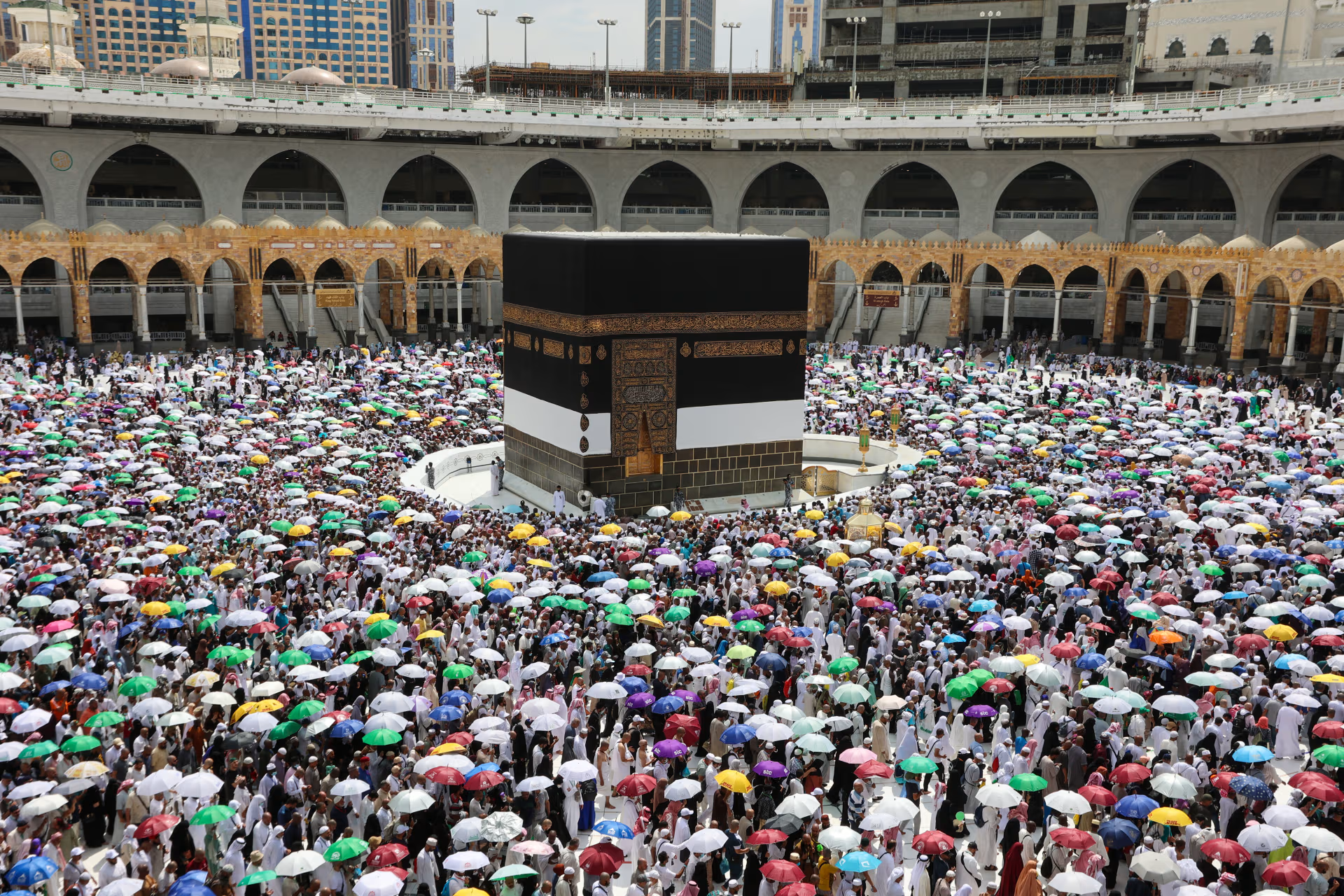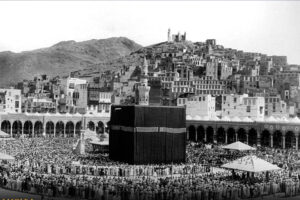The Great Spiritual Journey of Hajj and Umrah
Hajj and Umrah are magnificent spiritual journeys that take pilgrims through numerous historical and geographical sites of immense significance to Muslims. These sacred sites not only hold religious importance but also serve as a testament to Islam’s rich heritage. Below are some of the most prominent historical landmarks associated with this journey:
1. Hira Cave
Located on Jabal Al-Nour (Mountain of Light), approximately 5 kilometers northeast of the Holy Mosque in Mecca, Hira Cave holds great historical significance. It is the place where Prophet Muhammad ﷺ used to worship before his prophethood and where he received the first revelation of the Quran.
2. Thawr Cave
Situated on Jabal Thawr (Mount Thawr), about 7 kilometers south of Mecca, this cave is historically significant as the refuge of Prophet Muhammad ﷺ and Abu Bakr Al-Siddiq during their migration to Medina.
3. Al-Bai’ah Mosque
Located in Mina, around 8 kilometers east of the Holy Mosque in Mecca, this mosque marks the site where the Ansar pledged allegiance to Prophet Muhammad ﷺ in what is known as the Pledge of Al-Aqabah.
4. Al-Jinn Mosque
Situated in the Al-Ghazza district, 2 kilometers from the Holy Mosque in Mecca, this mosque is notable for the story of the Prophet ﷺ meeting a delegation of Jinn who embraced Islam.
5. Zamzam Well
Located within the Sacred Mosque near the Kaaba, this blessed well is tied to the story of Lady Hagar and her son Prophet Ishmael (peace be upon them). It continues to provide sacred water to pilgrims and worshipers from around the world.
6. Quba Mosque
Found in Medina, southwest of the Prophet’s Mosque and about 420 kilometers from Mecca, Quba Mosque was the first mosque built in Islam, established by Prophet Muhammad ﷺ during his migration to Medina.
7. Qiblatain Mosque
Located in Medina, approximately 420 kilometers from Mecca, this mosque is historically significant as the site where the Qibla was changed from Al-Aqsa Mosque in Jerusalem to the Sacred Mosque in Mecca during prayer.
8. Mount Arafat
Situated 22 kilometers east of the Holy Mosque in Mecca, this mountain is profoundly significant as the site of the central ritual of Hajj. Pilgrims gather here on the 9th of Dhul-Hijjah for supplication and worship.
9. Muzdalifah and Mina
Located between Arafat and Mecca, Muzdalifah (9 kilometers from the Holy Mosque) and Mina (7 kilometers from the Holy Mosque) are pivotal locations in the Hajj rituals. During the days of Tashreeq, pilgrims collect pebbles in Muzdalifah and stay in Mina to perform the symbolic stoning of the devil.
Standing at Arafat: The Greatest Pillar of Hajj
Standing at Arafat is the cornerstone of Hajj, without which the pilgrimage is incomplete, as the Prophet Muhammad ﷺ said, “Hajj is Arafat” (Narrated by Al-Tirmidhi). On this blessed day, pilgrims gather on the plain of Arafat, experiencing the grandeur of the moment. This gathering unites hearts and symbolizes equality before Allah, where worldly differences dissolve, and people are distinguished only by their piety. Allah glorifies this day by saying to the angels, “Look at My servants. They have come to Me disheveled and dusty, hoping for My mercy.”
The Sequence and Timing of Standing at Arafat:
- Preparations for Arafat: After entering the state of Ihram for Hajj, pilgrims proceed to Mina on the Day of Tarwiyah (8th of Dhul-Hijjah) and spend the night there. On the morning of Arafat (9th of Dhul-Hijjah), they head to the plain of Arafat to prepare for standing.
- Duration of Standing: The time begins at noon (Dhuhr) on the Day of Arafat and continues until the dawn of the Day of Sacrifice (10th of Dhul-Hijjah). It suffices for a pilgrim to be present in Arafat at any moment during this period, even briefly. However, it is recommended to stay from noon until sunset.
How to Perform the Standing at Arafat:
- Listening to the Sermon: Pilgrims listen to the sermon delivered at Namirah Mosque, where the speaker emphasizes the virtues of the day and the importance of sincerity in worship.
- Prayers: Pilgrims perform the Dhuhr and Asr prayers shortened and combined at Dhuhr time, with one call to prayer (Adhan) and two calls to commence (Iqamah), following the Prophet’s ﷺ tradition.
- Invocation and Supplication: After the prayers, the pilgrim stands anywhere within the boundaries of Arafat (clearly marked), engaging in remembrance and supplication. It is recommended to recite both traditional and personal prayers while raising the hands.
- Facing the Qiblah: Pilgrims are encouraged to face the Qiblah, feeling the closeness to Allah.
- Departure at Sunset: The standing continues until sunset, after which pilgrims calmly and serenely proceed to Muzdalifah.
Relation to the Farewell Sermon:
The Day of Arafat is closely tied to the Prophet Muhammad’s ﷺ Farewell Sermon, where he proclaimed the principles of humanity and Islam. He emphasized the sanctity of life, property, and honor, and urged adherence to the Quran and his Sunnah:
“I have left among you that which, if you hold on to it, you will never go astray: the Book of Allah and the Sunnah of His Prophet.”
On this day, the most profound message for humanity was revealed, announcing the completion of religion and the perfection of blessings:
“Today I have perfected for you your religion and completed My favor upon you and have approved for you Islam as your religion” (Al-Ma’idah: 3).
Wisdom Behind Standing at Arafat:
- Unity of the Ummah: It reflects the unity of Muslims as they gather humbly in a single location.
- Day of Forgiveness: It is a significant opportunity for repentance and the erasure of sins, as Allah frees His servants from Hellfire.
- Renewal of Commitment to Allah: Pilgrims realign their priorities, pledge obedience, and renew their faith.
The Message of Arafat:
Standing at Arafat is not merely a ritual but a moment to renew one’s relationship with Allah and shed the burdens of sin. It is a day when Muslims feel Allah’s closeness, inspiring them to reflect and transform, returning with a renewed spirit of faith and certainty.
This profound pillar of Hajj reminds us that Allah is ever near, ready to hear our supplications, answer our prayers, and grant us a fresh start in our lives.







